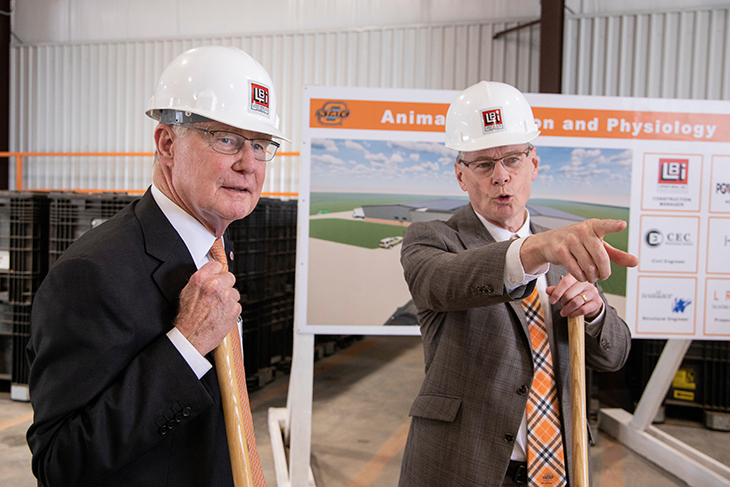
OSU’s new Animal Nutrition and Physiology Center to benefit all of Oklahoma, and beyond
Wednesday, June 5, 2019
Recent groundbreaking ceremonies for Oklahoma State University’s new Animal Nutrition and Physiology Center heralded a new era for the university’s longstanding commitment to the animal agriculture industry and animal well-being in general.
“Best management practices depend on the continual advancement of the science that leads to improved awareness and understanding about animal needs, and their interrelationship with the environment around them,” said Tom Coon, OSU vice president who leads the university’s Division of Agricultural Sciences and Natural Resources. “In turn, the science behind best management practices enhances the potential profitability of animal agriculture industries while strengthening the economic base of rural communities.”
Coon added the new center will be a place where the brightest minds at OSU conduct research, making discoveries and preparing undergraduate and graduate students researchers for the future.
“With research serving as an integral part of our Animal and Food Sciences and Natural Resource Ecology and Management programs, OSU’s land-grant mission to tackle concerns and issues of importance to Oklahomans requires modernized facilities that allow our faculty and student researchers to conduct needed science year-round,” he said.
The new OSU Animal Nutrition and Physiology Center will be a state-of-the-art facility dedicated to conducting animal studies primarily related to climate variability, production efficiency and sustainability in the areas of animal and human health; animal genetics, growth, nutrition and reproduction; and general animal well-being.
“Improvements in our ability to take observations from the field and test them in a more controlled setting stand to benefit all of Oklahoma, and beyond,” said Jim Long, Oklahoma Cooperative Fish and Wildlife Research Unit leader. “Take fish, for example: Fish live their lives largely invisible to us, underwater. Beyond people’s enjoyment of fishing and the money visiting anglers might bring to local communities, fish often serve as indicators about the health of our water resources.”
Long is quick to point out how science moves at the speed science moves, and that it is important for researchers to continually advance and review “accepted scientific findings.”
“You can’t just dial up scientific discoveries on a whim,” Long said. “Our responsibility is to keep doing the science and find out facts, and those facts are then used to develop the research-based best management practices that wildlife, livestock and land managers can use to accomplish their specific goals.”
Innovations at the new center will include:
• Individual stanchions and group pens to accommodate animals of all sizes;
• Metabolism stalls for the collection of waste and emissions;
• Specialized rooms with total climate control from 25 degrees Fahrenheit to 100
degrees Fahrenheit;
• A surgery room to accommodate large cattle, sheep and swine|;
• Wet and dry laboratory spaces;
• A fishery to perform ichthyological research; and
• Isolation rooms for livestock research under Biosafety Level 2 conditions.
One OSU scientist sure to make use of the Biosafety Level 2 isolation rooms in Glenn Zhang of the department of animal and food sciences, a professor of molecular immunology and holder of the university’s Boulware Endowed Chair whose research has led to the development of several innovative antibiotic-free strategies for use in both humans and livestock.
As stated by the World Health Organization: The rise in [bacterial] resistance to antibiotics is a threat to public health globally and there is a growing recognition that we may need to use antibacterial agents in a more judicious way.
“Antibiotics have been the cornerstone of therapy for bacterial infectious diseases in humans and animals, but there has been increased public awareness about the need to develop antibiotic-free strategies in recent years,” Zhang said. “The center will enhance our capabilities to conduct these very important scientific studies.”
In addition, the center will allow OSU students to perform and participate in intensive research projects in combination with applied animal studies at other facilities and make the university more competitive in garnering research funding.
“Increasing capabilities and research funding provides greater opportunities for OSU students to conduct innovative research as part of a high-quality, well-rounded education,” Coon said. “That not only benefits them and makes them more employable, it enhances the professional fields they will one day join. In turn, we all benefit.”
OSU President Burns Hargis agrees, citing how the Animal Nutrition and Physiology Center is indicative of the university’s commitment to its state and federally mandated land-grant mission.
“The land-grant mission is as vital today as ever, and the new center represents one of our many ongoing efforts to provide value to OSU students and all of Oklahoma, and beyond,” he said.
Additional information about the need for and ways to support Oklahoma State programs and facilities is available by contacting Megan Bryant of the OSU Foundation by email at mbryant@osugiving.com or by phone at 405-385-0743.
MEDIA CONTACT: Donald Stotts | Agricultural Communications Services | 405-744-4079 | donald.stotts@okstate.edu
